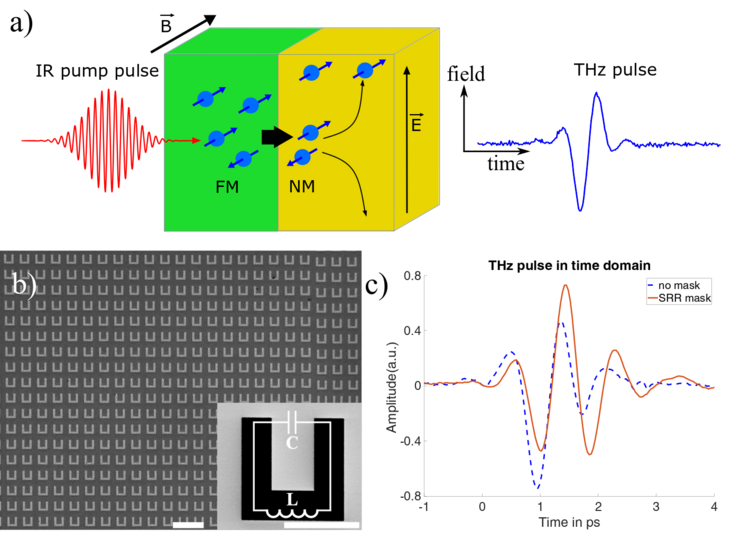Nanoscale Spintronic Terahertz Emitters
Contact
Prof. Dr. Sascha Schäfer
sascha.schaefer@uni-oldenburg.de
room W01A 1-105
telephone +49-441-798-3536
Nanoscale Spintronic Terahertz Emitters
The inverse spin Hall effect offers a promising approach for the generation of intense broadband terahertz radiation from optically driven ultrathin magnetic samples. In our group, we investigate how the spatial and spectral emission properties of such spintronic thin film systems can be tailored, utilizing terahertz resonator designs.
Recently, the generation of terahertz (THz) pulses from spintronic bi- and trilayer structures has been demonstrated, exploiting the inverse Spin Hall effect of optically induced spin-polarized currents [1]. The emitted single-cycle pulses show a broad and gapless spectrum with high peak field strengths, making spintronic THz emitters (STE) a promising approach for THz spectroscopy.
Furthermore, the spatial dimensions of the ultrathin spintronic emitter system, consisting of a few-nm thick ferromagnetic and non-magnetic layers, allows for a structuring of the emitter surface to change the emission characteristics.
In our lab, we investigate the emission properties of Pt/ Co4Fe4B2 metallic bilayer structures pumped by ultrashort infrared laser pulses. We focus on nanostructuring the thin bilayer emitter system to tailor its emission properties. Figure 1b shows focused ion beam milled STE with an array of complementary split-ring resonators (CSRR) [2]. These optical resonators are a promising candidate to enhance particular frequency components of the STE emission spectrum and imprint a spectral phase distribution on the emitted THz pulse.
This project is performed in collaboration with the Münzenberg group at the the Univ. Greifswald.
Figure 1: (a) Schematic operation principle of the spintronic terahertz emitter: An ultrafast optical laser pulse excites hot electrons in a ferromagnetic layer which results in a spin-polarized current diffusing into the non-magnetic layer. An oscillating dipole moment is induced due to the inverse Spin Hall effect which irradiates in the THz regime. Optical microscope (b) and scanning electron microscope image (inset) of a structured surface of STE and gold mask, respectively (scale bar: 50 µm). c) THz signal with (red) and without (blue dashed) a structured gold mask mounted behind the STE.
[1] T. Seifert et al. Efficient metallic spintronic emitters of ultrabroadband terahertz radiation, Nature Photonics, 10, 483 (2016).
[2] J.B. Pendry, A. J. Holden, D. J. Robbins and W. J. Stewart, Magnetism from Conductors and Enhanced Nonlinear Phenomena. IEEE trans. Microwave theory tech., 47(11), 2075, (1999).

